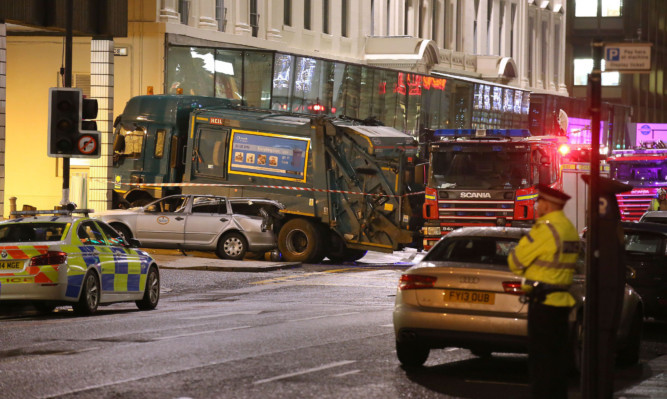The inquiry into the Glasgow bin lorry crash which claimed the lives of six people has heard there was a “clear disparity” between two accounts of a brief blackout suffered by the driver in 2010.
Glasgow Sheriff Court heard Harry Clarke told his GP the episode on April 7 five years ago happened in a work canteen.
But a letter from his then employer stated that the loss of consciousness took place on a stationary bus, the inquiry heard.
Mr Clarke, 58, was driving the council truck in Glasgow city centre on December 22 last year when he appeared to lose consciousness at the wheel and the lorry veered out of control.
A fatal accident inquiry (FAI) into the tragedy has heard he suffered from previous blackouts and dizziness dating back to the 1970s, but failed to notify the local authority when he applied for his post with them.
The FAI, now in its 10th day, has been hearing from Baillieston-based Dr Gerald McKaig, 50, who was Mr Clarke’s GP in 2010.
The inquiry has heard how his medical notes for the driver recorded he had a “five-second loss of consciousness” on April 7 2010.
It happened at work in the “hot environment” of the canteen, the notes recorded.
They added that there had been no warning signs of the incident, that Mr Clarke had felt “slightly disorientated” during the episode and that paramedics attended.
Dr McKaig, who said he had no clear recollection of the appointment, said his view at the time was that the incident was a “simple faint” and did not need to be reported to DVLA.
But the inquiry was also told of a letter dated April 8 2010 from Mr Clarke’s then employer, FirstBus, to another GP at the same medical practice.
It stated that the driver had had “an episode of loss of or impaired consciousness while on a stationary bus” the previous day.
The letter sought advice and said: “I understand he has been advised he does not need to inform the DVLA of the incident.”
Dr McKaig confirmed the information in the letter appeared to be different to the account he had received in relation to the location of the incident.
“There is a clear disparity between the descriptions,” the GP told the inquiry.
Questioned by Solicitor General Lesley Thomson QC, leading the inquiry, Dr McKaig confirmed the information in his notes would have come from one source, Mr Clarke.
Ms Thomson asked whether there was any room for the GP having got his notes wrong. “No, not at all,” he replied.
Erin McQuade, 18, and her grandparents Jack Sweeney, 68, and Lorraine Sweeney, 69, from Dumbarton, West Dunbartonshire, died from multiple injuries after being hit by the truck.
Stephenie Tait, 29, and Jacqueline Morton, 51, both from Glasgow, and Gillian Ewing, 52, from Edinburgh, were also killed as the lorry travelled out of control along Queen Street and towards George Square before crashing in to the side of the Millennium Hotel.
The Crown Office ordered an FAI into the crash after prosecutors ruled there was no evidence to warrant criminal proceedings.
